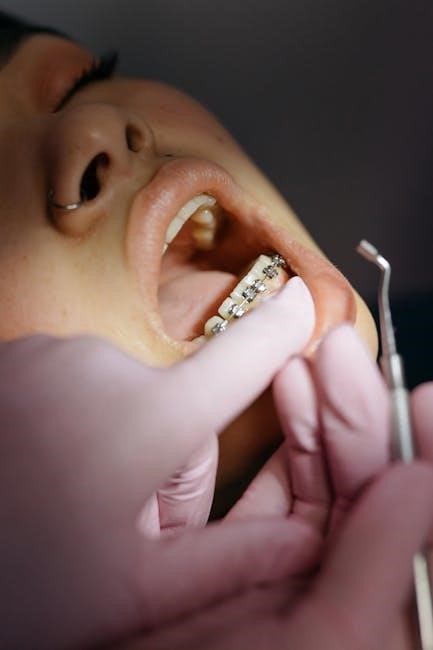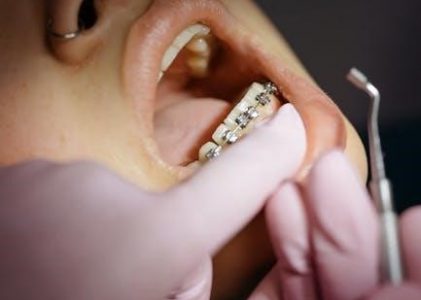Dental abbreviations are essential for efficient and accurate documentation in dental practice. They streamline communication, ensuring clarity and consistency in patient records, treatment plans, and billing processes.
1.1 Importance of Dental Abbreviations in Documentation
Dental abbreviations play a crucial role in maintaining clarity and precision in patient records. They ensure uniformity, reduce errors, and enhance efficiency in documentation. By standardizing terms, abbreviations facilitate quick reference and consistent communication among dental professionals. This consistency is vital for accurate treatment planning, billing, and legal compliance. Additionally, abbreviations help in organizing complex information succinctly, making documentation more accessible and time-efficient for practitioners. Their proper use balances brevity with clarity, ensuring that critical details are never overlooked.
1.2 Brief Overview of Common Dental Abbreviations
Common dental abbreviations include terms like “B” for buccal, “L” for lingual, and “O” for occlusal surfaces. Symbols such as circles and arrows denote specific conditions or treatments. Acronyms like “FMD” for Full Mouth Debridement and “FMX” for Full Mouth Series are frequently used. These abbreviations and symbols standardize documentation, ensuring clarity and consistency across records. They are essential tools for efficient communication in dental practice, aiding in quick reference and accurate record-keeping.
Common Dental Abbreviations and Symbols
Dental abbreviations and symbols are standardized shorthand used to document patient treatments, diagnoses, and procedures efficiently. They ensure clarity and consistency in dental records and communication.
2.1 Frequently Used Abbreviations in Dental Charts
In dental charts, common abbreviations include F (female), M (male), R (right), and L (left) for patient demographics. Tooth-specific terms like Max (maxilla), Mand (mandible), Bic (bicuspid), Can (canine), Inc (incisor), and Mol (molar) are frequently used. Additional symbols like Dist (distal), Mes (mesial), Occl (occlusal), Lab (labial), Ling (lingual), Pal (palatal), and Bucc (buccal) denote specific tooth surfaces. These abbreviations are standardized to ensure clarity and efficiency in documentation.
2.2 Symbols and Their Meanings in Dental Notations
Dental notations often include specific symbols to represent anatomical locations and conditions. For example, ↑ indicates the upper jaw, while ↓ denotes the lower jaw. Letters like R (right) and L (left) specify tooth location. Symbols such as ◯ for caries, △ for fractures, and ✓ for completed treatments are commonly used. These symbols enhance clarity and precision in documenting patient care, ensuring standardized communication among dental professionals.

Dental Acronyms and Initialisms
Dental acronyms and initialisms simplify complex terms, aiding communication. Examples include ADA (American Dental Association) and CBCT (Cone Beam Computed Tomography), enhancing efficiency in documentation and discussions.
3.1 Common Acronyms in Dental Practice
Dental practices frequently use acronyms to simplify communication and documentation. Common examples include CDP (Council on Dental Practice), FMC (Full Mouth Reconstruction), and ICD (International Classification of Diseases). These acronyms are essential for efficiency in patient records, treatment plans, and insurance billing. They ensure consistency and reduce errors in conveying complex information. Understanding these acronyms is crucial for professionals to maintain clear and accurate documentation, aligning with regulatory standards and best practices in dental care.
3.2 Specialized Initialisms in Dental Care
Specialized initialisms in dental care are tailored to specific procedures and treatments. For instance, OSA (Obstructive Sleep Apnea) and TMD (Temporomandibular Disorder) are commonly used. These initialisms help in documenting complex conditions concisely. They also facilitate clear communication among dental professionals, ensuring precise treatment plans and accurate patient records. By standardizing these terms, dentists maintain consistency and reduce ambiguity, enhancing overall patient care and documentation quality. These initialisms are particularly vital in specialized fields like orthodontics and oral surgery.

The Role of Abbreviations in Dental Practice
Dental abbreviations enhance efficiency, accuracy, and clarity in patient records, enabling quick communication and reducing documentation time while maintaining consistency across treatments and procedures.
4.1 Enhancing Efficiency in Patient Records
Dental abbreviations significantly enhance efficiency in patient records by reducing the time spent on documentation. Standardized abbreviations ensure consistency, making it easier for dental teams to quickly understand patient histories, diagnoses, and treatments. This clarity minimizes misunderstandings and streamlines communication among staff. By using recognized abbreviations, dental professionals can maintain accurate and concise records, allowing more time to focus on patient care and improving overall practice productivity. Uniform documentation also supports better organization and retrieval of patient information, ensuring reliable and efficient record-keeping.
4.2 Reducing Errors in Communication
Dental abbreviations play a crucial role in minimizing communication errors within dental teams. By using standardized abbreviations, professionals ensure clarity and consistency in patient records, reducing misunderstandings. Uniform terminology helps avoid ambiguity, fostering accurate interpretations of diagnoses and treatments. This precision is vital for effective collaboration among dentists, hygienists, and support staff. Clear communication enhances patient safety and outcomes, as errors in interpretation are significantly reduced. Regular use of recognized abbreviations further reinforces their effectiveness in maintaining reliable and error-free documentation. When in doubt, writing out terms is always recommended to ensure clarity and prevent miscommunication.

Legal and Professional Considerations
Legal and professional standards require uniformity in dental documentation to ensure compliance with regulatory standards, reducing liability risks and enhancing clarity in patient care and communication.
5.1 Uniformity in Dental Documentation
Uniformity in dental documentation ensures consistency across patient records, treatment plans, and billing processes. Standardized abbreviations and symbols, as outlined in resources like the Council on Dental Practice guidelines, help reduce errors and improve clarity. Consistent documentation fosters better communication among dental teams and compliance with legal standards, making it easier to track patient history and ensure accurate data exchange. This uniformity is crucial for maintaining professional integrity and meeting regulatory requirements in dental care.
5.2 Compliance with Regulatory Standards
Compliance with regulatory standards is crucial for maintaining legal and ethical integrity in dental practice. Standardized dental abbreviations ensure adherence to guidelines set by regulatory bodies, reducing risks of non-compliance. Using approved symbols and acronyms aligns documentation with legal requirements, such as GDPR for data protection. Non-compliance can lead to legal issues and fines, making it imperative to follow established standards. This ensures accurate record-keeping, protects patient data, and facilitates smooth audits, ultimately upholding professional trust and accountability in dental care.
Resources for Learning Dental Abbreviations
Recommended PDF guides and online courses provide comprehensive lists of dental abbreviations, symbols, and acronyms. These resources help professionals master standardized terminology for accurate documentation and communication.
6.1 Recommended PDF Guides and Manuals
Several comprehensive PDF guides are available to help professionals master dental abbreviations. The Council on Dental Practice (CDP) provides detailed lists of approved abbreviations, symbols, and acronyms. Additionally, resources like “Oral Health Care: A Whole New Language” offer in-depth explanations and practical examples. These PDF manuals are invaluable for dental students, hygienists, and administrators, ensuring standardization and clarity in documentation. They also serve as quick reference tools for everyday practice, promoting efficiency and accuracy in patient care and communication.
6.2 Online Courses and Training Materials
Online courses and training materials are excellent resources for mastering dental abbreviations. Platforms like Dental CE Hub and the American Dental Association (ADA) offer comprehensive webinars and continuing education courses. These programs often include interactive modules, quizzes, and downloadable PDF guides. They are designed to help professionals stay updated on standardized abbreviations, ensuring accurate documentation and compliance with regulatory standards. Many courses also provide real-life scenarios to practice applying abbreviations, making learning engaging and practical for dentists, hygienists, and billing specialists.

Best Practices for Using Dental Abbreviations
Best practices include using standardized abbreviations consistently, avoiding ambiguity, and referencing official guides to ensure clarity and accuracy in patient records and communications.
7.1 Consistency in Documentation
Consistency in dental documentation is crucial for clear communication among healthcare providers. Using uniform abbreviations ensures accuracy and reduces errors in patient records. A centralized abbreviation key, accessible to all staff, helps maintain uniformity. This practice minimizes misunderstandings and ensures compliance with professional standards. Consistency also aids in training new team members, promoting a cohesive workflow. By adhering to standardized abbreviations, dental practices can enhance patient care and operational efficiency effectively.
7.2 Avoiding Ambiguity in Abbreviated Terms
Avoiding ambiguity in dental abbreviations ensures precise communication and prevents misinterpretations. Clearly defining unclear terms or using standardized lists can minimize confusion. When abbreviations are unclear, it’s best to write them out fully. Regular training and updates on accepted abbreviations help maintain clarity. Using context clues and cross-referencing with patient records also reduces ambiguity. Consistent use of approved abbreviations fosters accurate documentation and effective care delivery.
Understanding dental abbreviations is crucial for clear communication and effective patient care. Mastering these terms enhances documentation accuracy and efficiency, ensuring better outcomes in dental practice.
8.1 Summary of Key Points
Dental abbreviations are crucial for efficient communication in dentistry, ensuring clarity and consistency in patient records and treatment plans. They simplify documentation, enhance productivity, and reduce errors. Uniformity in their use is essential for compliance with regulatory standards. Resources like PDF guides and online courses provide comprehensive learning tools. Mastering these abbreviations fosters effective communication among dental professionals, ensuring high-quality patient care and adherence to legal requirements.
8.2 Final Thoughts on Mastering Dental Abbreviations
Mastering dental abbreviations is key to efficient and accurate communication in dental practice. Consistent use enhances documentation, reduces errors, and ensures compliance with professional standards. Leveraging resources like PDF guides and online courses can significantly improve proficiency. By staying updated and adhering to best practices, dental professionals can deliver high-quality care while maintaining clear and precise records. This mastery not only elevates patient care but also reinforces the professionalism of dental practitioners worldwide.

